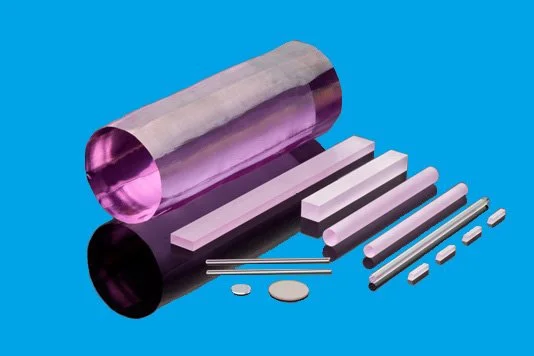Nonlinear and Laser Crystals
Nonlinear crystals are specialized materials that enable the alteration of laser light frequency through nonlinear optical processes, such as second-harmonic generation and parametric oscillation. These crystals play a crucial role in manipulating light, making them essential components in laser technologies like frequency doubling and optical parametric amplifiers.
Laser crystals serve as the gain medium in lasers, amplifying light when energized by an external source, such as a flashlamp or diode.
Nd:YAG Laser Crystals
Nd:YAG Laser Crystals
Neodymium-doped Yttrium Aluminum Garnet (Nd:YAG) crystals are among the most widely used laser crystals in various high-performance laser systems. These crystals serve as a gain medium in solid-state lasers, where the neodymium ions provide the active lasing material. Nd:YAG lasers are known for their high efficiency, excellent thermal conductivity, and versatility, operating at fundamental wavelengths like 1064 nm and harmonic wavelengths such as 532 nm (green) and 355 nm (UV). Their unique properties make them ideal for continuous wave (CW), pulsed, and Q-switched laser operations, enabling their use in diverse fields such as industrial manufacturing, medical procedures, scientific research, and military applications.
In the industrial sector, Nd:YAG lasers are essential for precision material processing tasks, including welding, cutting, and engraving, thanks to their high power and focusable beam quality. In medicine, these lasers are utilized for surgeries, particularly in ophthalmology and dermatology, due to their precision and minimal thermal damage to surrounding tissues. Nd:YAG lasers also play a critical role in scientific applications like nonlinear optics, where they serve as a pump source for generating other laser wavelengths. Furthermore, they are deployed in military applications, such as range finding and target designation, due to their reliability and robustness under varying conditions. Their widespread utility underscores the critical importance of Nd:YAG crystals in advancing laser technology across industries.
Firebird Optics offers several standard configurations as well as the ability to customize a solution for you. Please reach out to us at info@firebirdoptics.com
Specs for Nd:YAG Laser Crystals:
Nd:YAG Laser Crystals: A Cornerstone of Laser Technology
Neodymium-doped Yttrium Aluminum Garnet (Nd:YAG) crystals are among the most widely used solid-state laser materials, known for their excellent optical properties, thermal conductivity, and versatility. These crystals have become the backbone of laser systems across a variety of fields, including industrial manufacturing, medical procedures, scientific research, and defense applications. With a high gain efficiency and the ability to operate at various wavelengths and pulse modes, Nd:YAG lasers provide reliable and precise performance for applications requiring power, precision, and durability.
What Are Nd:YAG Crystals?
Nd:YAG crystals are synthetic materials made by doping Yttrium Aluminum Garnet (Y3Al5O12) with neodymium ions (Nd3+), which act as the active lasing element. These crystals exhibit a broad absorption band in the near-infrared region, allowing them to efficiently absorb energy from flashlamps or diode lasers. The most common lasing wavelength for Nd:YAG lasers is 1064 nm, in the near-infrared spectrum, but they can also generate harmonic wavelengths at 532 nm (green), 355 nm (UV), and 266 nm (deep UV) through nonlinear optical processes.
The physical and thermal properties of Nd:YAG crystals make them highly efficient and durable in demanding laser operations. They boast excellent thermal conductivity, enabling stable performance under high-power conditions. Furthermore, their ability to operate in continuous wave (CW), pulsed, and Q-switched modes provides users with significant flexibility, making Nd:YAG crystals a preferred choice in a wide range of laser technologies.
Applications of Nd:YAG Crystals
Industrial Applications
In the industrial sector, Nd:YAG lasers are essential tools for precision material processing. They are widely used in welding, cutting, drilling, and engraving due to their high beam quality and power output. For example, their ability to cut through metals and other tough materials with minimal heat-affected zones makes them invaluable in automotive and aerospace manufacturing. Additionally, their adaptability to operate in different modes allows for the optimization of processes depending on the material and desired outcome.
Medical Applications
Nd:YAG lasers are also pivotal in the medical field, where their precision and minimal invasiveness are highly valued. They are commonly employed in ophthalmology for procedures such as posterior capsulotomy and laser iridotomy, as well as in dermatology for skin resurfacing and tattoo removal. Their wavelength of 1064 nm penetrates deeply into biological tissues, making them suitable for coagulation and tissue removal with minimal thermal damage to surrounding areas.
Scientific Research
In scientific research, Nd:YAG lasers play a critical role in nonlinear optics, serving as pump sources for generating other wavelengths through processes like second-harmonic generation (SHG). They are also widely used in spectroscopy and remote sensing, where their stable and precise output enables the detection and analysis of minute changes in environmental or experimental conditions.
Challenges in Manufacturing Nd:YAG Crystals
The production of Nd:YAG crystals requires highly controlled conditions to achieve the desired optical purity and uniformity. These crystals are typically grown using the Czochralski method, a process that involves slowly pulling a single crystal from a melt at high temperatures. Maintaining the correct concentration of neodymium ions and minimizing inclusions or defects are critical to ensuring the crystals meet the stringent requirements of advanced laser systems.
Advancing Photonics with Nd:YAG Crystals
Nd:YAG crystals are a cornerstone of modern photonics, providing the foundation for powerful and versatile laser systems. From cutting-edge industrial processes to lifesaving medical procedures and groundbreaking scientific research, these crystals enable technologies that have transformed multiple industries. As advancements in laser technology continue, Nd:YAG crystals remain indispensable, paving the way for even more innovative applications.






